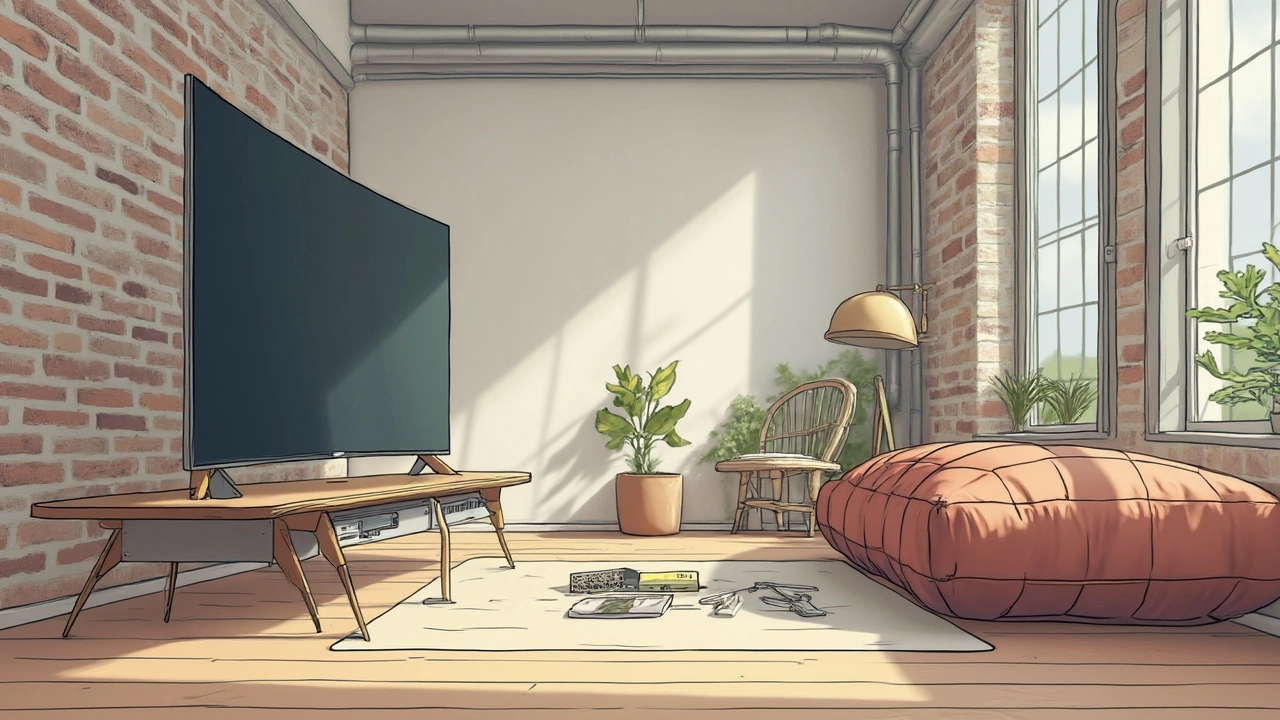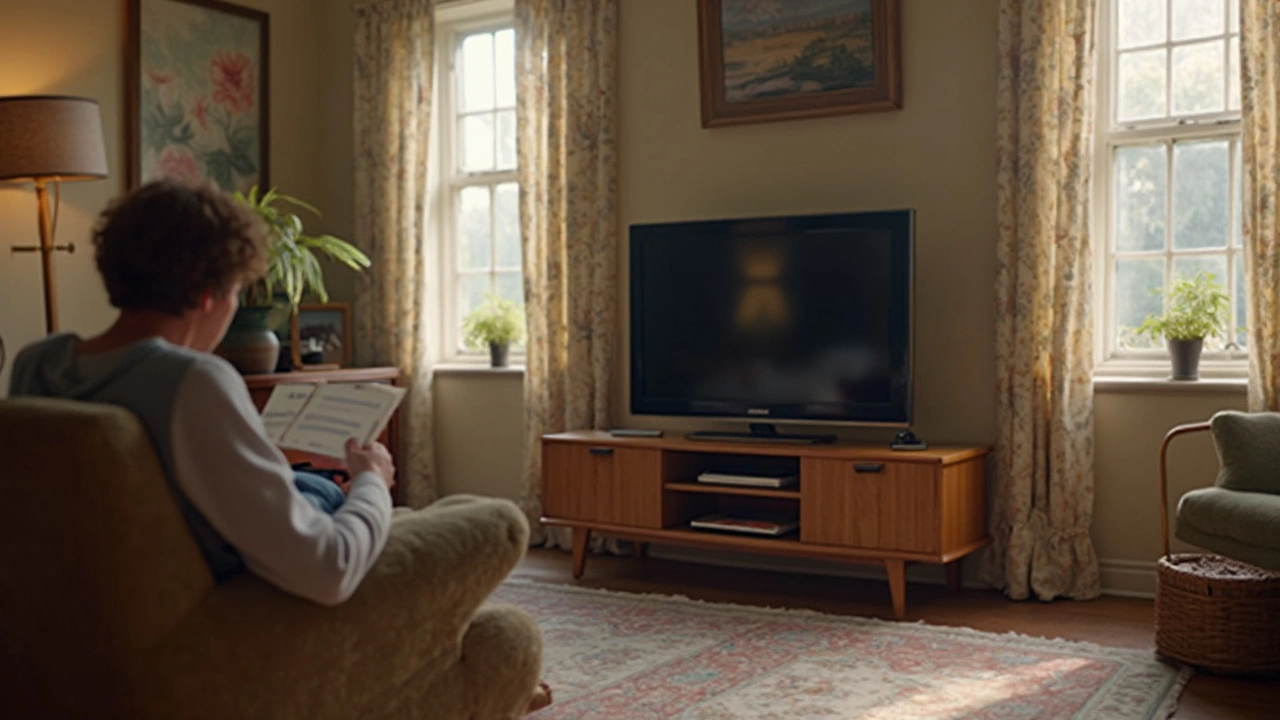So, you've got your shiny new smart TV, and you're eager to set it up. But wait—do you know how to properly attach the stand? It might sound simple, but doing it right is important to ensure your beloved gadget doesn’t meet an untimely demise. Plus, you want that screen to stand tall and proud, right? Here's a quick guide to help you put that stand on with confidence.
First off, understand that not all stands are created equal. Some TVs come with pre-included stands tailored specifically for them, while others require you to purchase one separately. This makes selecting the appropriate stand a crucial first step. Make sure the stand is compatible with your TV's size and weight. If it wobbles even a bit, it might not be the match for you.
Now, onto assembling the stand. Most stands come with instructions, but who actually reads them, right? Well, maybe just this once. Assemble the pieces carefully and double-check everything is snug and fastened. A poorly assembled stand is like a dodgy table—nobody wants to deal with that mess.
- Choosing the Right Stand
- Assembling the Stand
- Attaching the Stand to the TV
- Safety Tips and Final Adjustments
Choosing the Right Stand
Picking the right stand for your smart TV is like choosing the perfect pair of shoes—it needs to fit just right. First thing's first, make sure the stand is compatible with your TV's size and also its weight. You don't want an underpowered stand struggling to hold your TV upright.
Next, think about the style. Do you prefer a minimalist look or something more robust and traditional? Your room's decor should guide your choice, as the stand will be the foundation of your entertainment setup. Some stands double as furniture, offering shelves or compartments for storing gadgets and cables, which can be a game changer if you're low on space.
Material matters too. Stands come in all sorts of builds, from glass and metal to wood. Each has its pros and cons. Wooden stands are sturdy and fit well in any traditional setup, while glass can add a modern touch but requires more caution against breaks or cracks. Metal frames are sleek and contemporary but can be heavy.
Speical Considerations
- VESA Compatibility: Make sure the stand mounts properly with your TV using the VESA standard pattern.
- Adjustability: Some stands allow for the TV to be swiveled or tilted. If your seating area isn't centered, you might find this feature handy.
- Height: The ideal viewing angle is at eye-level when you’re sitting down. Make sure your chosen stand provides the right height.
If you're into numbers, here's a quick look at some average weights:
| TV Size | Average Weight |
|---|---|
| 32-40 inches | 15-25 kg |
| 41-50 inches | 25-35 kg |
| 51-60 inches | 35-45 kg |
Remember, you can always check the manufacturer's guidelines for any special instructions related to stands. Armed with this info, you're all set to pick a stand that will keep your TV standing proud and secure.
Assembling the Stand
Alright, you've picked the perfect smart TV stand that matches your TV's size and style. Now comes the assembly—a process that might test your patience, but it's totally doable. Let's break it down.
Step-by-Step Assembly Guide
- Read the Instructions: Yeah, it’s boring, but those papers actually help. Most TV stands come with handy diagrams that can make the process a lot less confusing.
- Lay Everything Out: Organize all the parts and screws on the floor or a table. It saves you from hunting for missing bits halfway through. You'll likely have a couple of brackets, a handful of screws of various sizes, and maybe some tools (if you're lucky).
- Start with the Base: Assemble the base part of your stand first because it provides stability. Attach any legs or wheels if your model has them. Make sure everything is lined up straight before tightening screws.
- Add the Mounting Brackets: These brackets will connect the stand to your TV. Some stands require you to attach the brackets directly to the base, while others have a more complex setup. Either way, double-check that everything is secured tightly. Nobody wants a lopsided TV!
- Double Check Security: Wiggle the base and brackets. If they move, tighten them up a bit more. A loose screw here can mean trouble later on.
Most setups should take around 20 to 30 minutes, depending on your experience and the complexity of the stand. Remember, there's no rush. Take your time to ensure everything is rock solid.
Tool Tips
Many TV stands come with their own toolkits. But if they don't, or if they're somehow too flimsy, your basic household screwdrivers should do the trick. A power drill can speed things up, but be careful not to overtighten anything.
If you hit a snag or something doesn’t seem right, don’t force it. Check back with the instructions or, if worst comes to worst, the manufacturer’s helpline is a lifesaver.
| Assembly Time | Difficulty Level |
|---|---|
| 20-30 minutes | Moderate |

Attaching the Stand to the TV
Alright, you've chosen the right stand and assembled it with precision. Now, it's time to attach it to your smart TV. Don't worry, it’s not as tricky as it sounds, but a little attention to detail goes a long way. Let's break it down step by step.
Gathering the Essentials
Before you start, make sure you’ve got all the necessary screws and tools handy. Most TVs will include a little pack of screws that are just right for mounting the stand. You'll typically need a basic screwdriver, but check those instructions just to be sure.
Securing the Stand
Lay your TV on a flat, soft surface. This helps prevent any unnecessary scratches. Trust me, a scratched screen will dampen your excitement real quick. Carefully line up the stand with the holes on the back of the TV.
- Align the Stand: Find the mounting holes on your TV and align them with the stand's brackets. This might take a little patience, but it’s crucial for stability.
- Insert the Screws: Once aligned, insert the screws through the brackets into the TV. Make sure they go in straight to avoid stripping them. Tighten them just enough to hold, but don’t go overboard. You want to keep your TV secure, not crack the casing!
- Double-Check Stability: With everything attached, gently lift the TV to an upright position. Give it a slight nudge to see if there are any wobbles. If it feels stable, you’re golden! If not, lay it back down and double-check those screws.
Sometimes, the stands also come with a safety bracket for added security. If yours does, take the extra time to attach it. Safety first, folks!
Extra Tips for the Cautious Ones
If you’re feeling extra cautious, check to see if your TV manual mentions the smart TV setup specifics for attaching the stand. It may vary slightly depending on the brand or model you’ve chosen. For some added peace of mind, consider investing in anti-tip straps if you have kids or pets. These can prevent accidental bumps from turning into disasters.
By the end of this process, your TV should be standing confidently on its stand, ready to bring you countless hours of entertainment. Just a few measured steps to get there!
Safety Tips and Final Adjustments
Alright, you've assembled your TV stand and attached it to your smart TV. But before you call it a day, let's make sure everything is safe and sound. After all, the last thing you want is your prized big screen taking a nosedive.
Check the Stability
Start with giving your TV a gentle nudge to see if it wobbles. If it does, you might need to tighten a few screws or reposition the base. A stable stand is crucial for keeping your TV upright and secure.
Position it Right
Where you place your TV matters a lot. Avoid putting it near high-traffic areas where it might get knocked. Also, keep it away from heating elements or windows that let in a lot of sunlight—no one wants a warped screen!
According to Mark Peterson, a leading home electronics expert: "Proper installation not only improves TV installation but extends the lifespan of your device by safeguarding it against common household risks."
The Final Adjustments
- Ensure cables have enough slack. Tight cables can accidentally tug your TV when you least expect it.
- Avoid draping anything over the TV. It might block vents, potentially causing overheating issues.
- Mount or store game consoles and streaming boxes neatly under or to the side to reduce the clutter and potential tipping hazards.
And if you're someone who likes diving into stats, here's an interesting tidbit:
| Year | Household TV Tip-Over Incidents (in thousands) |
|---|---|
| 2020 | 17 |
| 2022 | 12 |
| 2024 | 10 |
So, follow these smart TV setup tips, and you'll likely avoid becoming a part of those stats. Keep your entertainment hub safe and sound, and enjoy your TV hassle-free.


Write a comment